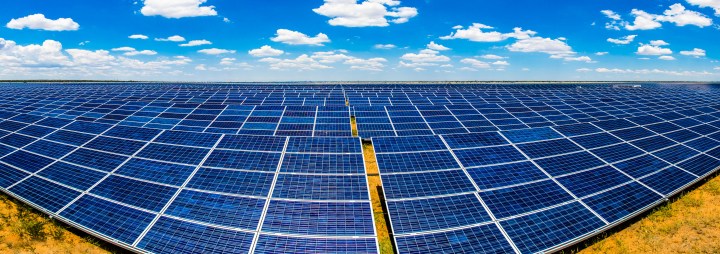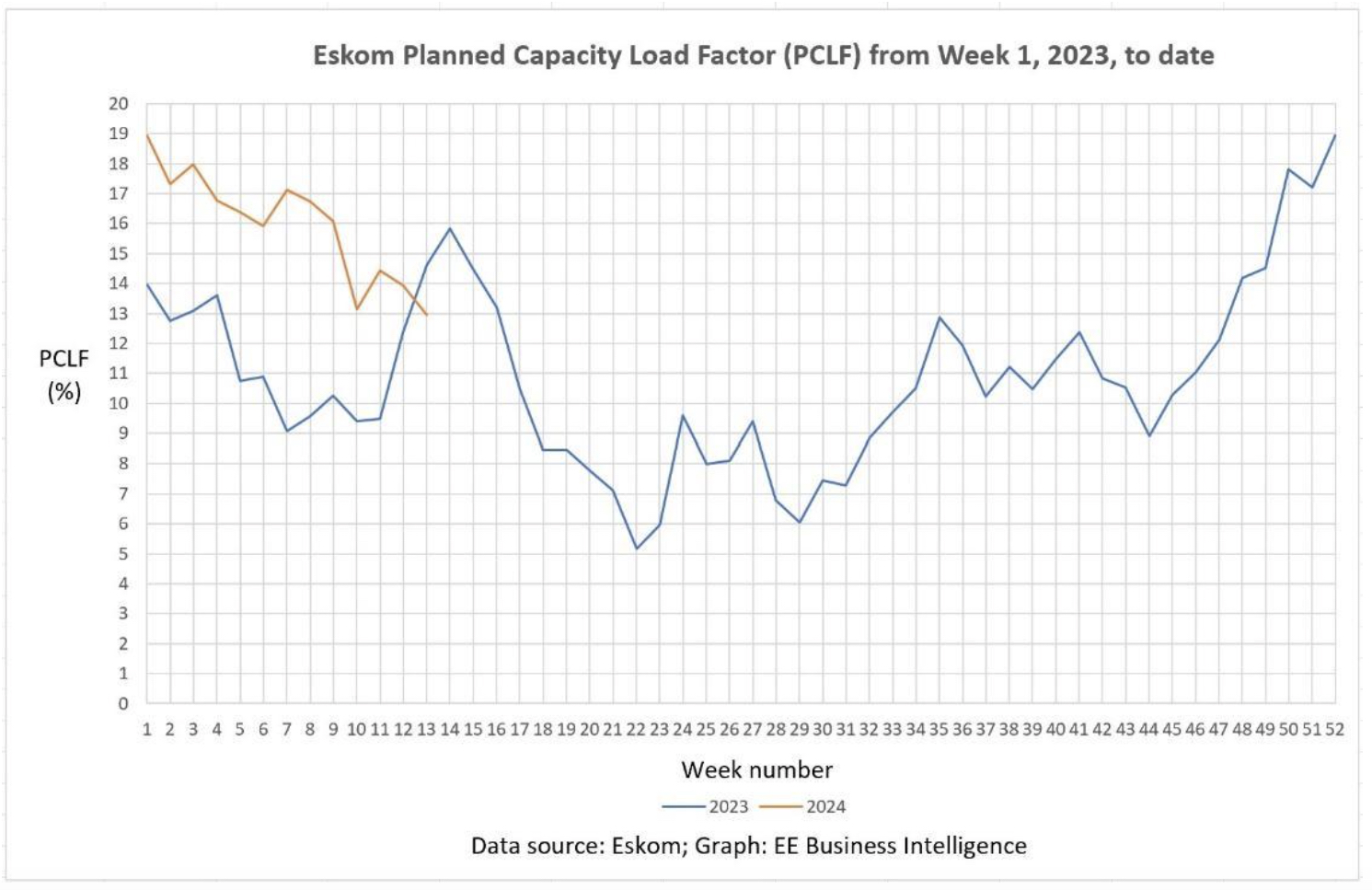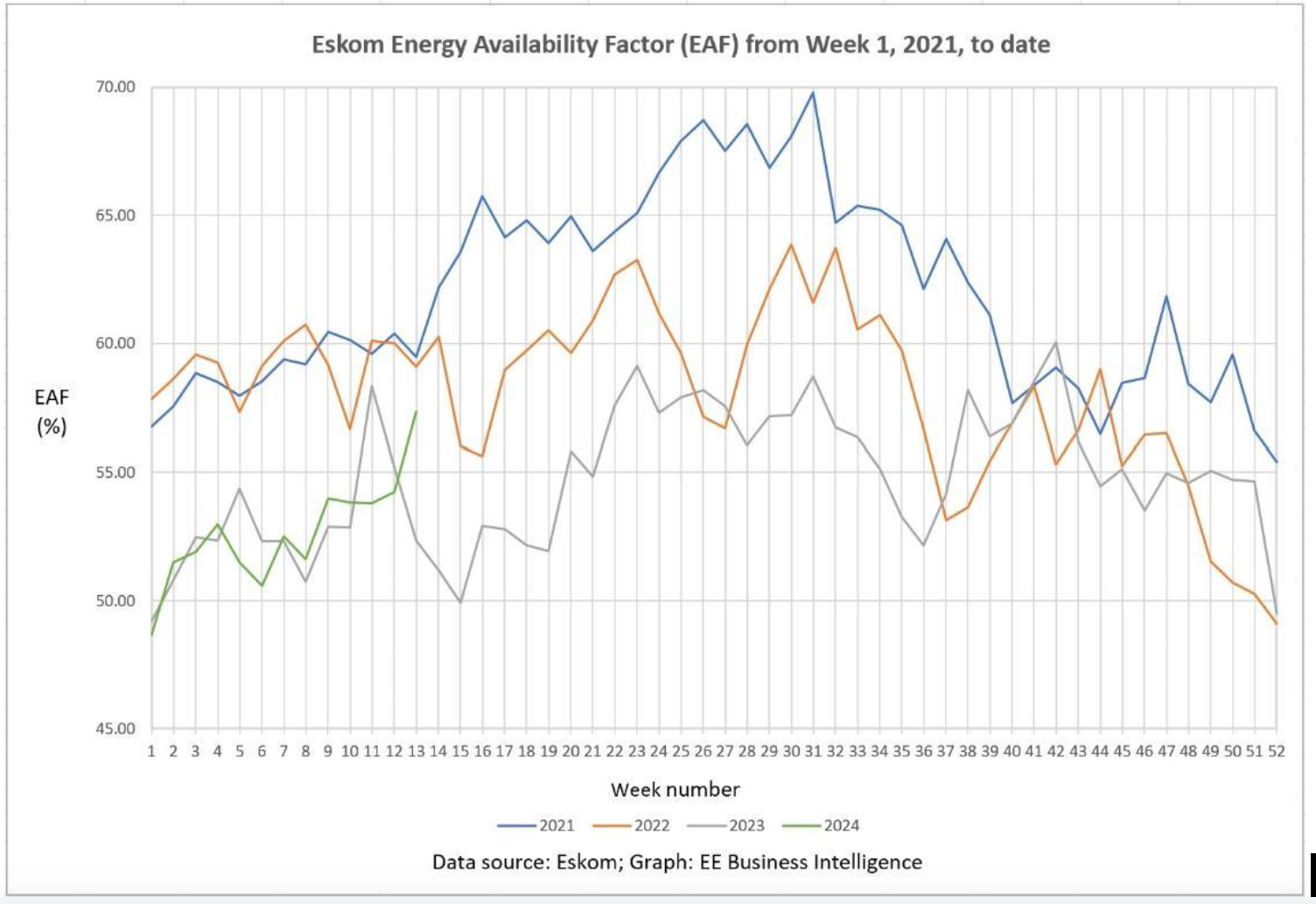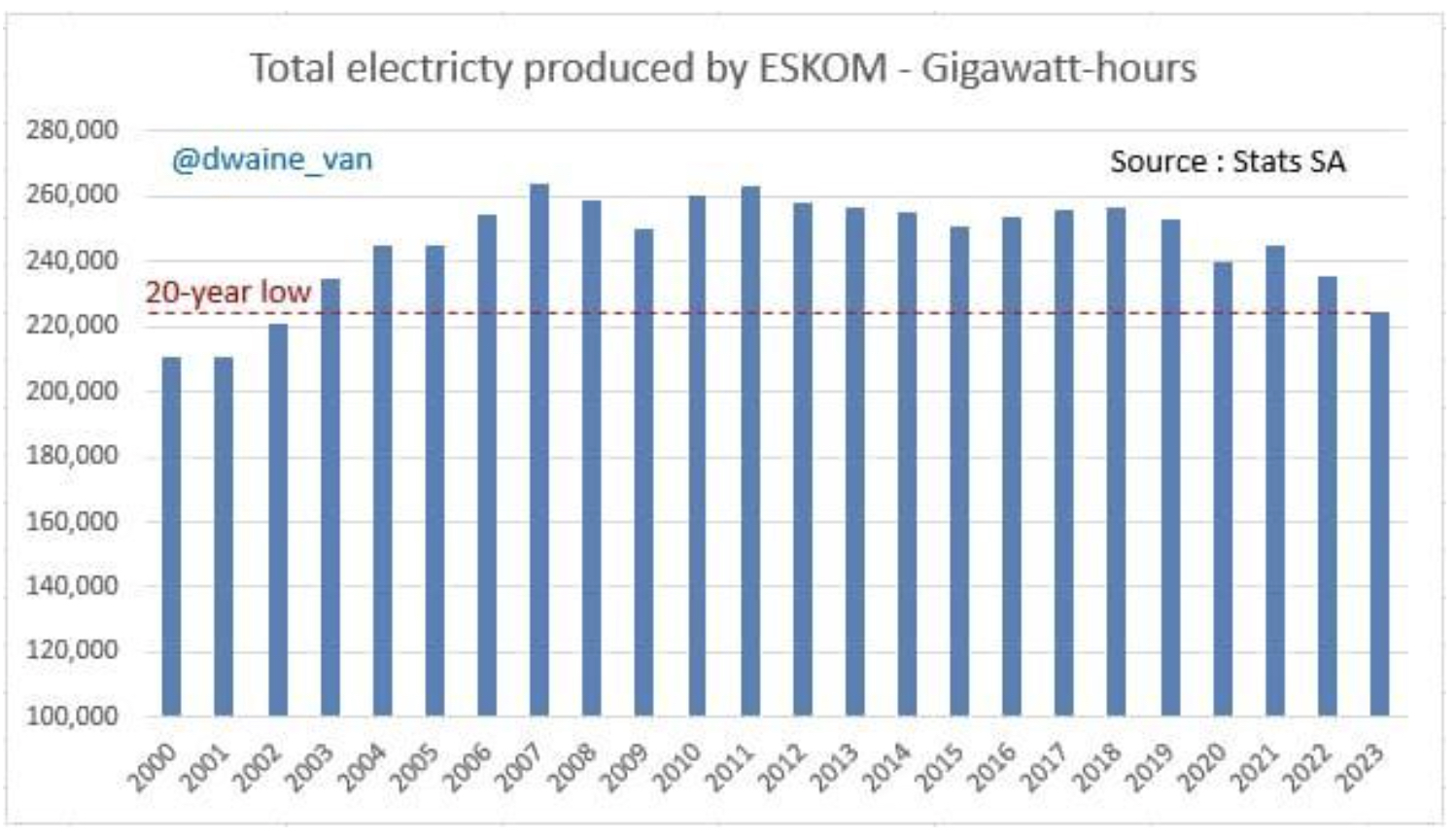POWER CRISIS OP-ED
Why is there less load shedding? There’s a fundamental change taking place in SA’s electricity sector

The electricity supply industry in South Africa is in a state of flux, including a significant reduction in the intensity and frequency of load shedding. Electricity customers may be wondering what is going on.
While unplanned breakdowns (UCLF) are down this year compared with the same period last year (Fig. 1), this is offset by increased planned maintenance outages (PCLF) this year, compared with the same period last year (Fig. 2). Thus, the availability of the Eskom fleet (EAF) this year is similar to that of the same period last year (Fig. 3).
So, why are we experiencing less load shedding this year compared with the same period last year?

Fig 1: Week-on-week Eskom Planned Capacity Load Factor (PCLF) from Week 1, 2023, to date.

Fig. 2: Week-on-week Eskom Unplanned Capacity Load Factor (UCLF) from Week 1, 2023, to date.

Fig. 3: Week-on-week Eskom Energy Availability Factor (EAF) from Week 1, 2023, to date.
The answer is that demand for Eskom grid electricity continues to decline (Fig. 4), because of:
- The weak South African economy, and the resulting generally flat overall demand for electricity;
- The rapidly rising price of Eskom and municipal electricity of two to three times the inflation rate for many years, is dampening demand for Eskom-generated electricity;
- Load shedding and the low reliability of Eskom and municipal grid electricity, particularly over the past four years, has been negatively affecting electricity supply;
- Electricity customers are responding by moving to self-generation and alternative energy sources, including rooftop solar PV, battery energy storage, gas for cooking, solar hot water geysers, energy efficiency and a general reduction in demand for grid electricity; and
- The pipeline of big renewable energy and battery energy storage plants is now coming to the grid, and this trend is accelerating.

Fig. 4: Total electricity (GWh) produced by Eskom per year from 2000 to 2023. (Data source: Stats SA; Graph: Stats & Facts @dwain-van on X, 5 April 2024)
All this is relieving Eskom of a burden that it has been struggling to meet over the past few years, and this is resulting in a significant reduction in the frequency and intensity of load shedding this year compared with the same period last year.
So, Eskom has been in a death spiral of rising Eskom prices and load shedding, causing customers to move to alternative energy sources, causing declining Eskom sales volumes, causing rising prices to recover fixed Eskom costs off declining sales volumes, and so on.
At the same time, the utility has also been in something of a debt spiral, which has been arrested for the time being by government bailouts from National Treasury, which has put a moratorium on significant new debt by Eskom.
The utility death and debt spirals, and Treasury, are now forcing Eskom and the whole electricity supply industry in South Africa to restructure, unbundle and increase the role of the private sector in financing, construction, operation and maintenance of electricity generation, transmission and distribution infrastructure in South Africa.
This should not be seen as the privatisation of Eskom, but rather as increasing public participation in the business of Eskom by development finance institutions, commercial banks, pension funds, other financial institutions, business, industry and the public.
In transmission, we are seeing the creation of a nominally independent, state-owned national power transmission operating company (NTCSA), an independent market operator (IMO), and an electricity market in South Africa. We will also likely see new high-voltage transmission corridors that will be financed, built, operated and maintained via public-private partnership (PPP) concessions (like toll road concessions), because Eskom does not have the resources, money or balance sheet for this.
In generation, we are seeing the emergence of a diversified and competitive power generation sector, comprising Eskom and former Eskom generators, PPP generators, municipal generators, hundreds of independent power producers (IPPs), and literally thousands of big, medium and small “prosumers” (customers who are both producers and consumers of electricity).
Instead of Eskom being the single buyer of electricity from its own generators and from IPPs, there is an increasing trend of wheeling and trading of electricity between independent power producers, generators and traders to a multitude of customers across publicly owned electricity grids in southern Africa.
Read more in Daily Maverick: Eskom news
A fundamental change is taking place in the electricity sector of South Africa as it starts to catch up with those in many other parts of the world. This change is in progress now, but is not a fait accompli yet, and it could be reversed if reactionary, backward-looking naysayers and “doolittles” in the country, with vested interests in the failed status quo, get their way politically.
But there is reason for optimism. The pace of reform in the electricity supply industry of South Africa is now gathering momentum, driven by the need for decarbonisation and security of supply, and the reality of the economic imperatives.
There is also a growing multiparty consensus in Parliament on the passage of the long-awaited Electricity Regulation Amendment Bill. Once promulgated, the new act will provide the necessary legal, policy, regulatory and planning framework for the envisaged reforms, and the future electricity supply industry in South Africa.
However, what remains to be seen are the necessary reforms in the significantly dysfunctional Eskom and municipal and electricity distribution industry. This thorny issue is still unresolved. DM
Chris Yelland is managing director, EE Business Intelligence.
© Copyright 2024 – EE Business Intelligence (Pty) Ltd. All rights reserved. This article may not be published without the written permission of EE Business Intelligence.




 Become an Insider
Become an Insider
Solar plus storage on the consumer side of the meter has changed things already and this will accelerate.
Cheaper than grid power. Reliable.
At factory we have not run diesel at all since Oct 2023, whereas at times we were doing R60k – R80k per month diesel. Our solar output is up 40% because it now runs fullspeed during loadshed. We self-consume more of our solar by way of very large battery system.
Prediction : by 2027 that annual Eskom supply number will be closer to 150 TWh than 200 TWh.
Come 30 May 2024, all loadshedding will be back again… We saw this picture before.
Sadly…
Sport on. The ANC have politicised (and weaponised) electricity and water for decades.
Well done DM ! We were indeed wondering “….Electricity customers may be wondering what is going on.” Thanks to you and Chris Yelland we now have some idea of the status quo. A positive answer in a sea of negativity, by the realist, and no-nonsense Yelland.
Electricity is so expensive…..the private sector will sell at a profit, via BEE and other middlemen
Geoff: electricity users in effect have a decision to make:
A. Stay grid-dependent, with whatever that brings in terms of cost and reliability.
B. Go big solar and big storage to hedge say ¾ of your annual cost at far lower than grid for 20 years while at same time becoming immune to even stage 10 loadshedding. It is not as difficult as people imagine, excepting maybe if you don’t have enough sunny roof space.
…or an asbestos roof which no installer will touch.
Installers are not allowed to work on asbestos – DoL has been tightening up on the existing regulations. And Municipalities won’t approve the projects.
Chris Yelland knows the electricity supply game. of that there is no doubt. But something to consider besides the extra power now coming on stream plus lower demand, is this. Is the ANC also pushing old power stations beyond their limits to score election points by curtailing blackouts? Matshela Koko did this to great effect when we hosted the World Cup soccer. Only problem is he drove everything into the current state of destruction we are now living with. The ANC will be shouting loudly about how they’re restoring everything now, including a collapsing Eskom.
Hi Rae,
If you look at the first graph, PCLF (they are referenced incorrectly in the text) you will see that up until a couple of weeks ago, Eskom was actually doing a lot more maintenance than last year, (good) but on a steeply declining trend (bad). No doubt this will continue to decrease until the end of May, in order to fool the electorate into thinking that the ANC government is getting it right.
Thereafter, it’s anyone’s guess. I suspect that, given that Eskom is almost entirely controlled by deployed ANC cadres, they will do whatever their political bosses tell them to do, rather than what’s best either for Eskom or for RSA, Inc.
Big question is when can I start spinning my domestic elec meter backwards?
Pha-lese! It is just that: the privatisation of electricity generation in SA.
ESKOM is generating significantly less electricity today than in 2024. It is an enterprise hobbled by debt. Much of this could have been avoided had ESKOM taken the risk of investing in renewable infrastructure 20 years ago. It didn’t. Or rather, it refused to.
Instead, pegging its future fortunes on nuclear generation, they dithered, they wagged NERSA, they uhmmed, arrhhed, and scratched the proverbial. With tortoise-like haste, they measured the wind-speed along the south Cape coast: for ten years. They invented 1984-speak terminology like “loadshedding”, “base-load”, and my favourite, “the Sun doesn’t shine at night.”
And here we are.
Watching the privatisation of ESKOM.
2004, of course!
I remember something about Economics 101. It had to do with supply and demand and price, a super simple curve which says that when one goes up the other goes down. And oh yes! Something about butter and margarine.
So let’s see. The price of something goes up. So people buy less of it. Now supply goes down and it becomes quite scarce. This causes the price to go up. But supply is also erratic and unrealiable. But now people have found a cheaper alternative. They decide to switch. Competitive forces cause investment and R&D into the alternative causing the price to drop further. Which cause more and more people to switch.
Now the people producing the original thing say all is well because they have invested money and have fixed the supply problems. But the price is still high because they borrowed money to fix the problems. Unfortunately there’s nobody left to buy their product. Now they can’t afford to pay their debt.
Something like that!
Absolutely nailed it. But when Eskom dies its eventual death, fingers will be pointed at REIPPP and the private sector, rather than admitting that the organisation completely squandered its window of opportunity.
Ditto the Post Office and SAA. Our ANC gov basically allowed the private sector to pull the rug out from under their feet: Courier companies took over most of the PO functions and Safair took out SAA. Privatisation by default. But that’s what you get when you use unqualified cadres to run your operations.
It is much less complicated than that. There is an election coming. A week is a long time in politics. Load shedding will resume on May 10
Exactly. I mean, who on earth actually believes that, all of a sudden, following SofaGate Cyril’s announcement of the election date, a whole lot of solar generated electricity came on stream, and that happened at precisely the same moment as demand for electricity collapsed? No doubt those two elements play a role, but come on folks – the election ploy here is so obvious it can’t even be considered mildly humorous.
I still want to see more hydro-electric pump storage power stations similar to Ingula, which will enable far more storage of electricity at only a fraction of the cost of battery OR hydrogen storage. Hydrogen can still be rolled out as a way of powering transport, especially heavy & long distance transport. For shorter trips and light vehicles BEV (Battery-only electric vehicles) will be fine, and it seems that this is already starting to take off, with hydrogen infrastructure to be developed for especially our highways to take care of the longer distances, heavier transport and vehicles such as trucks, trains & aeroplanes. I believe that Sasol & Toyota and Anglo American are all working on this. But for storage of electricity, by far the most cost-efficient way is by means of pump storage. For instance, 23 Ingula’s can give the whole of SA a full night of electricity even if there is no electricity generation at all (+-27GW for 16 hours = 432 GWh). But at night there will be generation from wind & for the next 11 years coal power also. The coal stations can then gradually be replaced by a combination of renewables and pump storage, together with the expansion of the grid capacity. This will work, provided that proper planning is done and the proper discipline exists with the execution. From there on, more pump storage must then gradually be built to store the renewable energy which by then there will be no shortage of. This is the most cost-effective sustainable solution.
One thinks of possibilities – dam sites on the Umkomaas have been mooted and investigated from even before democracy to feed the urbanised complex of Pietermaritzburg and Durban. Like Ingula, it might be interesting to look at Lesotho dam sites downstream of Katse possibly feeding into the headwaters of the Umkomaas. The length of tunnel might be slightly longer than the Orange-Fish Tunnel. If there is a substantial height difference generating possibilities arise.
One thinks of possibilities – dam sites on the Umkomaas have been mooted and investigated from even before democracy to feed the urbanised complex of Pietermaritzburg and Durban. Like Ingula, it might be interesting to look at Lesotho dam sites downstream of Katse possibly feeding into the headwaters of the Umkomaas. The length of tunnel might be slightly longer than the Orange-Fish Tunnel. If there is a substantial height difference generating possibilities arise.